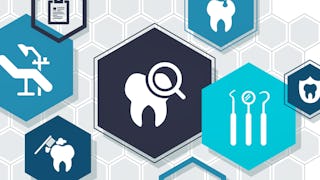Understanding the clinical terms and abbreviations commonly used during verbal or written communication in U.S. hospitals is challenging. This course is designed for U.S. health care profession students and for international students and practitioners who want to become more familiar with the language of the U.S. clinical setting. Others, such as caregivers and medical interpreters, who wish to develop a better understanding of terms and abbreviations used by health care providers will find this course helpful. The course provides visual and auditory learning experiences to enhance the understanding of terms and abbreviations commonly encountered on a general U.S. hospital unit. You need to pay the fee or apply for financial aid to access the course and earn a certificate. To find out more, click Learn more and apply next to the information about Financial Aid. (Use a computer, not a mobile device, for this step.)

3 days left: Get a Black Friday boost with $160 off 10,000+ programs. Save now.


Clinical Terminology for International and U.S. Students

Instructor: Valerie Swigart, Ph.D. R.N.
133,902 already enrolled
(3,202 reviews)
Skills you'll gain
Details to know
44 assignments
See how employees at top companies are mastering in-demand skills

There are 6 modules in this course
In the Module 1 video lecture, I introduce the course and strategies for understanding the structure of clinical abbreviations and complex terms. In Module 1 readings, we focus on learning abbreviations related to vital signs. Understanding the structure of abbreviations will help you to identify the meaning of abbreviations presented in this course, as well as those you encounter in the future.
What's included
1 video12 readings6 assignments1 discussion prompt
In Module 2, we expand our focus to learn about abbreviations and terms used in the hospital environment. You will tour a modern U.S. clinical unit and visit the bedside of three patients. These vicarious bedside experiences will help you to imagine the context in which the terms and abbreviations are used. Making associations of the terms or abbreviations to specific people, places or types of patients will help to “set” them in your memory. Begin Module 2 by previewing the complex medical terms you will find in this lesson and sharpening your skills for analyzing the structure of complex terms.
What's included
8 videos14 readings10 assignments
In Module 3, I share more strategies toward discovering the meaning of complex medical/scientific words. The focus is on three essential clinical topics: abbreviations used in emergency situations, the timing and route of medications, and the administration of intravenous infusions. Learning about abbreviations related to medication and intravenous fluid administration requires that you pay close attention.
What's included
2 videos8 readings4 assignments
This module turns the focus to the acronyms commonly substituted for the name of diseases and conditions of the bodily systems. To help you relate the disease and its acronym, we have organized the diseases according to systems of the body. First letters of words or syllables usually form the acronym, and commonly at least one letter relates to a system of the body.
What's included
1 video13 readings9 assignments
The lecture for this module focuses on the important aspects of patient safety when using abbreviations. The readings focus on laboratory tests and diagnostic procedures. A patient-case approach is used to help you make associations between diseases and the tests or procedures typically required.
What's included
1 video15 readings8 assignments
As you worked through Modules 1-5 you have learned about abbreviations and terms used every day in clinical practice. Now you are ready to use your new knowledge and test your comprehension skills. In this module, you see and hear clinical conversation in reality-based video simulations.
What's included
8 videos5 readings7 assignments
Instructor

Offered by
Explore more from Patient Care
 Status: Free Trial
Status: Free TrialRice University
 Status: Preview
Status: PreviewUniversity of Pittsburgh
 Status: Free Trial
Status: Free TrialRice University
 Status: Free Trial
Status: Free Trial
Why people choose Coursera for their career




Learner reviews
3,202 reviews
- 5 stars
84.79%
- 4 stars
13.30%
- 3 stars
1.40%
- 2 stars
0.24%
- 1 star
0.24%
Showing 3 of 3202
Reviewed on May 7, 2020
The course added so much to my clinical experience and learning specific terms which i was not familiar with! I recommend it to all International students that don't have lectures in English.
Reviewed on Sep 18, 2021
As a beginner in Medical Terminology, this course was very useful in general comprehension of the clinical setting, and I already use my knowledge in my medical translation work. Thank you so much!
Reviewed on Oct 12, 2021
Hands down this course was nothing short than amazing! its helpful informative and it challenge you to want to go further into the medical field. every instructor was excellent.

Open new doors with Coursera Plus
Unlimited access to 10,000+ world-class courses, hands-on projects, and job-ready certificate programs - all included in your subscription
Advance your career with an online degree
Earn a degree from world-class universities - 100% online
Join over 3,400 global companies that choose Coursera for Business
Upskill your employees to excel in the digital economy
Frequently asked questions
Yes! Coursera provides financial aid to learners who would like to complete a course but cannot afford the course fee. To apply for aid, select "Learn more and apply" in the Financial Aid section below the "Enroll" button. You'll be prompted to complete a simple application; no other paperwork is required.
Medical terms, abbreviations and acronyms are a large part of the verbal and written communication that occurs in clinical situations in the U.S. Abbreviations are used to increase efficiency by shortening the time to communicate. If you want to join in any conversation about clinical matters, you will need to understand terms, abbreviations and acronyms.
You can always ask for clarification. However, clinical settings in U.S. hospitals are often very busy, noisy places with people hurrying to meet patients’ needs. There will be little time for explanation of word meanings. The more emergent the situation, the more likely it is that abbreviations will be used. When you know a term or abbreviation before hearing it on the clinical unit, you will be a better communicator and more effective healthcare team member.
More questions
Financial aid available,

